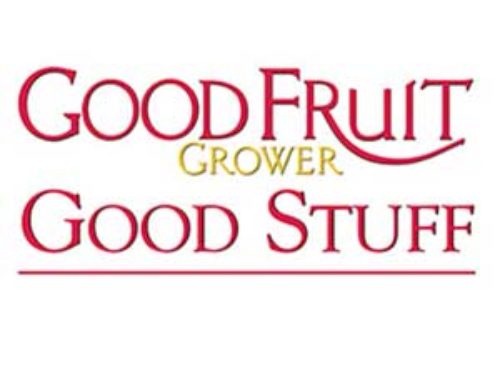
Unpruned 0900 Ziraat trees (above) tower over visitors
in 1995.
Photo by Lynn Long
By Lynn Long
I first visited the cherry production regions of Turkey in 1995. At that time, I found evidence of generally high-quality fruit being produced with little understanding of sound horticultural principles. In 2005, I returned to attend the fifth International Cherry Symposium, in Bursa, about 4 hours due south of Istanbul across the Marmara Sea. Much has changed in the last ten years.
In 1995, Turkey was just starting to impact the European market in such a way that European cherry growers were fearful of the competition. Turkish growing techniques were very primitive, wages were extremely low, and the war in the Balkans often disrupted the shipment of cherries from Turkey to Europe. I was eager to see the progress that had been made in the last decade.
My host was Cihangir Korkmaz, nursery manager for Alara Corporation, the largest exporter of fresh cherries in Turkey, controlling 24 percent of the market. The vast majority of export-quality cherries grown in Turkey find their way to Europe, a fact that is not lost on European cherry growers. Due to very low wages, they know that Turkish growers can produce cherries at a fraction of the European cost.
Wherever you travel within Europe, cherry producers are talking about the impact of Turkish cherries on their industry. Turkish speakers are invited to grower conferences, and markets abound with high quality Turkish cherries that compete well with local fruit.
Obviously, Turkey’s impact on the European market has not lessened in the last ten years. In an article that I wrote for Good Fruit Grower, published in June 1996, I predicted that within a few years Turkey would overtake the United States as the largest cherry producer in the world. That prediction came true within a few years. For the years 1996-1999, the average production in Turkey was 215,000 tons, surpassing the 180,000-ton U.S. average.
Varieties
Good soils, a perfect climate, and the fact that sweet cherries are native to this area of Asia Minor mean that Turkey has perfect conditions to grow sweet cherries throughout the country. Although Turkey is, for the most part, a one-variety producer, the production region extends over such a vast area, through changing climate and elevation, that the production season continues for 60 to 70 days.
With the introduction of new early varieties from California and late varieties from Canada, the potential is an April through August harvest. The primary variety grown for export is 0900 Ziraat. This mid- to late-season variety ripens between Bing and Lapins and is a mahogany cherry with pink flesh.
It is very firm with excellent flavor. On standard rootstocks such as Mahaleb, the tree tends to be nonprecocious and nonproductive, a problem that is compounded by the fact that most growers don’t use bees for pollination. Even the need for pollinizer varieties is sometimes not well understood.
In 1995, I heard of one newly planted 0900 Ziraat orchard of 80 acres that had been planted without any pollinizers. Although it is still easy to find examples of poor horticultural practices in Turkey, it is obvious that much progress has been made. One of the main reasons for these advancements is companies such as Alara.
Not only does Alara package and export cherries, but it has its own orchards scattered throughout the country that it uses for demonstration purposes. In 1995, Turkish scientists were beginning to work on cherry-related issues of importance to the industry, but they lacked an associated Extension Service to help disseminate new concepts to the growers.
Alara helps to fill that gap by inviting their growers to corporation-owned orchards where they conduct trainings. In 2004, Alara hosted more than 300 trainings throughout the country. As many as 300 to 400 growers participate, but typically 60 to 70 people will attend a training that may last three to four days. At these trainings, growers learn about pest management, proper irrigation practices, the advantages of dwarfing rootstocks, and how to train and prune trees.
Pruning
Pruning was a practice that was totally unknown to most growers in 1995. Trees towered over me as I walked through orchards, and I saw spurs that were 12 inches long. After touring cherry production areas around the world, Alara founder Yavuz Taner asked Alara growers if they were in the furniture business or the fruit business.
In order to get growers to prune, he not only had to pay them to prune, but offered to reimburse them for any trees that died as a result of pruning. Today, about half of the growers prune, but pruning knowledge is still very rudimentary among traditional growers. Most growers prune out dead wood and cut back the top to keep the tree smaller and easier to harvest. However, they still lack an understanding of basic light management.
Surprisingly, many growers are planting new blocks on Gisela rootstock, a trend that started with Alara. The Alara corporate orchards began to convert from Mazzard in 1999. These orchards are as modern as any I have seen in the world.
The Alara Corporation has converted waste land to acre after acre of irrigated, high-density cherry trees, trained to the Vogel Spindle. Alara orchards are well planned and managed, and are run by highly educated engineers and technicians who are constantly seeking to increase their knowledge of cherry production. Each year, Alara takes their orchard managers abroad to study production practices in such places as Holland, Germany, and Belgium.
High density
It’s not only the Alara corporate orchards that are transitioning to high density plantings on Gisela rootstock. Seventy percent of the new plantings by traditional growers who grow for Alara are on Gisela rootstock, trained to the Vogel system. Gisela 5 is the most popular rootstock, but on poorer soils, Gisela 6 is recommended.
When soils are deemed adequately porous, Alara growers are required to choose a Gisela rootstock in any new planting. One of the advantages that Alara has over its competitors is the fact that it produces its own nursery stock for itself and its growers. Alara holds the exclusive license for Gisela in Turkey.
This year, Alara sold about 500,000 cherry trees, an indication as to how quickly cherry production is expanding in Turkey. Its biggest customer is the Turkish Ministry of Agriculture. In order to help subsidize these new plantings, the government purchases Gisela-rooted trees for $12, or Mazzard-rooted trees for $6 and sells them to growers at half price. m





Leave A Comment